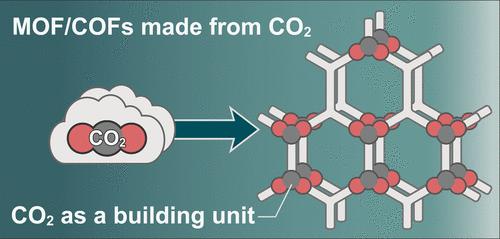当前位置:
X-MOL 学术
›
Acc. Chem. Res.
›
论文详情
Our official English website, www.x-mol.net, welcomes your
feedback! (Note: you will need to create a separate account there.)
Conversion of Carbon Dioxide into Molecular-based Porous Frameworks
Accounts of Chemical Research ( IF 16.4 ) Pub Date : 2024-10-14 , DOI: 10.1021/acs.accounts.4c00519 Kentaro Kadota, Satoshi Horike
Accounts of Chemical Research ( IF 16.4 ) Pub Date : 2024-10-14 , DOI: 10.1021/acs.accounts.4c00519 Kentaro Kadota, Satoshi Horike

|
The conversion of carbon dioxide (CO2) to value-added functional materials is a major challenge in realizing a carbon-neutral society. Although CO2 is an attractive renewable carbon resource with high natural abundance, its chemical inertness has made the conversion of CO2 into materials with the desired structures and functionality difficult. Molecular-based porous materials, such as metal–organic frameworks (MOFs) and covalent–organic frameworks (COFs), are designable porous solids constructed from molecular-based building units. While MOF/COFs attract wide attention as functional porous materials, the synthetic methods to convert CO2 into MOF/COFs have been unexplored due to the lack of synthetic guidelines for converting CO2 into molecular-based building units.
中文翻译:

将二氧化碳转化为基于分子的多孔框架
将二氧化碳 (CO2) 转化为高附加值功能材料是实现碳中和社会的一大挑战。尽管 CO2 是一种极具吸引力的可再生碳资源,具有很高的自然丰度,但其化学惰性使得 CO2 转化为具有所需结构和功能的材料变得困难。分子基多孔材料,如金属有机框架 (MOF) 和共价有机框架 (COF),是由基于分子的建筑单元构成的可设计多孔固体。虽然 MOF/COF 作为功能性多孔材料引起了广泛关注,但由于缺乏将 CO2 转化为分子建筑单元的合成指南,将 CO2 转化为 MOF/COF 的合成方法尚未得到探索。
更新日期:2024-10-14
中文翻译:

将二氧化碳转化为基于分子的多孔框架
将二氧化碳 (CO2) 转化为高附加值功能材料是实现碳中和社会的一大挑战。尽管 CO2 是一种极具吸引力的可再生碳资源,具有很高的自然丰度,但其化学惰性使得 CO2 转化为具有所需结构和功能的材料变得困难。分子基多孔材料,如金属有机框架 (MOF) 和共价有机框架 (COF),是由基于分子的建筑单元构成的可设计多孔固体。虽然 MOF/COF 作为功能性多孔材料引起了广泛关注,但由于缺乏将 CO2 转化为分子建筑单元的合成指南,将 CO2 转化为 MOF/COF 的合成方法尚未得到探索。






























 京公网安备 11010802027423号
京公网安备 11010802027423号